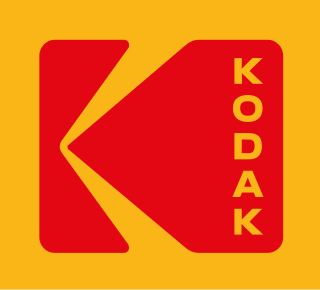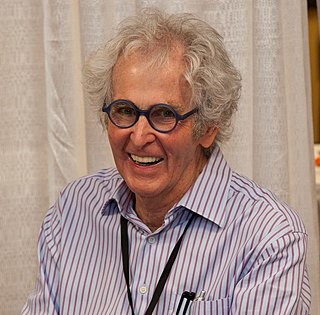
The Eastman Kodak Company is an American public company that produces various products related to its historic basis in analogue photography. The company is headquartered in Rochester, New York, and is incorporated in New Jersey. Kodak provides packaging, functional printing, graphic communications, and professional services for businesses around the world. Its main business segments are Print Systems, Enterprise Inkjet Systems, Micro 3D Printing and Packaging, Software and Solutions, and Consumer and Film. It is best known for photographic film products.
Todd Jay Weinstein is a photographer and artist, born in Detroit, Michigan, and who now lives in New York City. Todd’s first started photography back in high school in the mid 1960’s. After graduating high school he studied at the Center for Creative Studies under his teacher George Phillips. Worked as 3rd assistant to the photographer Dick James studio in Detroit Michigan, after moving to New York City in 1970 Todd started working at the Gaslight folk music club which move to upstairs at Max's Kansas City. Was also part of the theater troop The Banana Company. With the luck of meeting the photographer Burt Stern’s assistant Dwight Carter who introduce Todd to the photographer Mel Dixon who give Todd his first job as his assistant. Todd started to work for other photographers. Harvey LLoyd working in audio visual with images and sounds and assisted and taught with his mentor and teacher Ernst Haas from 1972-1986,. Working as a freelance photographer team up with the photographer Bob Day in 1973 to start Dove Studio, producing Audio/Visual presentation for museums, and corporations. In 1975 started Todd Weinstein Production working as a freelance photographer, and a producers of special projects for many clients. While always spending time keeping his personal work in tandem started using a Leica range finder camera with 35mm 400 high speed color negative film which was now available to work more spontaneously. Todd has lectured and taught in the USA and abroad, published many articles, and won several awards and honors, including Artist-in-Residence, Germany for his project "Darkness into light: Re-emergence of Jewish Life in Germany".

Ernst Haas was an Austrian-American photojournalist and color photographer. During his 40-year career, Haas bridged the gap between photojournalism and the use of photography as a medium for expression and creativity. In addition to his coverage of events around the globe after World War II, Haas was an early innovator in color photography. His images were disseminated by magazines like Life and Vogue and, in 1962, were the subject of the first single-artist exhibition of color photography at New York's Museum of Modern Art. He served as president of the cooperative Magnum Photos, and his book The Creation (1971) was one of the most successful photography books ever, selling 350,000 copies.

Jerry N. Uelsmann is an American photographer and was an early exponent of photomontage in the 20th century in America. His work in darkroom effects foreshadowed the use of Adobe Photoshop to make surrealistic images in the late 20th century, a process led by his now-ex-wife, Maggie Taylor, at that time. He received a Guggenheim Fellowship in 1967, a National Endowment for the Arts Fellowship in 1972, and the Lucie Award in Fine Art in 2015. He is a Fellow of the Royal Photographic Society of Great Britain, a founding member of The Society of Photographic Education.

Stock photography is the supply of photographs which are often licensed for specific uses. The stock photo industry, which began to gain hold in the 1920s, has established models including traditional macrostock photography, midstock photography, and microstock photography. Conventional stock agencies charge from several hundred to several thousand United States dollars per image, while microstock photography may sell for around USD 25 cents. Professional stock photographers traditionally place their images with one or more stock agencies on a contractual basis, while stock agencies may accept the high-quality photos of amateur photographers through online submission.

Minor Martin White was an American photographer, theoretician, critic, and educator. He combined an intense interest in how people viewed and understood photographs with a personal vision that was guided by a variety of spiritual and intellectual philosophies. Starting in Oregon in 1937 and continuing until he died in 1976, White made thousands of black-and-white and color photographs of landscapes, people, and abstract subject matter, created with both technical mastery and a strong visual sense of light and shadow. He taught many classes, workshops, and retreats on photography at the California School of Fine Arts, Rochester Institute of Technology, Massachusetts Institute of Technology, other schools, and in his own home. He lived much of his life as a closeted gay man, afraid to express himself publicly for fear of loss of his teaching jobs, and some of his most compelling images are figure studies of men whom he taught or with whom he had relationships. He helped start, and for many years was editor of, the photography magazine Aperture. After his death in 1976, White was hailed as one of America's greatest photographers.

The term alternative process refers to any non-traditional or non-commercial photographic printing process. Currently the standard analog photographic printing process is the gelatin silver process, and standard digital processes include the pigment print, and digital laser exposures on traditional color photographic paper.

A real photo postcard (RPPC) is a continuous-tone photographic image printed on postcard stock. The term recognizes a distinction between the real photo process and the lithographic or offset printing processes employed in the manufacture of most postcard images.
Lisette Model was an Austrian-born American photographer primarily known for the frank humanism of her street photography.

Jerry Avenaim is an American photographer best known for his fashion and celebrity images.

Alyson Hunter is a New Zealand photographer and print maker, resident in London, who, during the 1970s and 1980s, employed an unusual technique of etching with a chemically modified photographic image.

Susan Hacker Stang is an American photographer, author, and educator.
John Paul Caponigro is an Environmental Fine Art Landscape Photographer. He is the son of the American photographer Paul Caponigro and Eleanor Caponigro a graphic designer. John Paul attended Yale University, and the University of California, Santa Cruz where he was trained as a painter and later as a photographer. After college John moved to Maine and became an artist in residence at The Center for Creative Imaging. John now works with photo-based digital imaging as his primary medium. Dan Steinhardt of Epson considers John Paul "...one of the great mentors of the photographic medium". The American photographer Joyce Tenneson has said, "John Paul Caponigro is the rare combination of gifted artist and master technician. He works from the heart to create images that are poetic and evocative, and at times, mystical. He is someone whose sensitivity and intelligence work to break new ground, and someone I will enjoy watching in the years to come.". He has been awarded membership into many photographic organizations including the Photoshop Hall of Fame, the Epson Stylus Pros, Xrite Coloratti, and the Canon Explorers of Light. His work crosses the lines between photography and painting and displays knowledge of painterly composition and color theory, coupled with content of modern science, psychology, primal cultures, and the environment. The photographer Arnold Newman stated,"...Caponigro's mysterious and magical images go beyond reality or surrealism. He has created a wonderful new world of his own". John Paul Caponigro lives in Cushing, Maine with his photographer wife Arduina, and their son.
Marc Muench is an American photographer who specializes in sports and landscape photography.
Michelle Bates is an American photographer, teacher and author who specializes in images taken with toy cameras. She has been exhibiting her work, teaching classes and workshops, and writing about photography since 1991.

Light Work is a photography center in Syracuse, New York. The artist-run nonprofit supports photographers through a community-access digital lab facility, residencies, exhibitions, and publications.

Visual Studies Workshop (VSW) is a non-profit group dedicated to art education based in Rochester, New York. VSW supports makers and interpreters of images through education, publications, exhibitions, and collections. VSW runs a bookstore, exhibition gallery, and research center.
Joyce Neimanas is an American artist known for her unorthodox approach to photography and mixed-media works.
Vincent Versace is an American photographer and a Nikon Ambassador. He is a recipient of the Computerworld Smithsonian Award in Media Arts & Entertainment. His work is part of the permanent collection of the Smithsonian Institution's National Museum of American History.

Arthur Ollman is an American photographer, author, curator, professor emeritus (San Diego State University, and founding director of The Museum of Photographic Arts, San Diego. He served as MoPA director from 1983 to 2006, and as director of the School of Art, Design and Art History, SDSU, from 2006 to 2011. He was president of the board of directors for the Foundation for the Exhibition of Photography and has authored and contributed to more than twenty-five books and catalogs.












